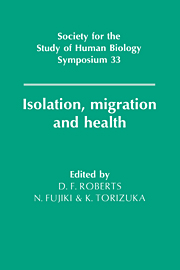Book contents
- Frontmatter
- Contents
- List of contributors
- Preface
- 1 The legacy of the IBP: Presidential Address
- 2 The distinction between primary and secondary isolates
- 3 Time trends in the break-up of isolates
- 4 Factors influencing the frequency of consanguineous marriages in Japan
- 5 Break-up of isolates
- 6 Isolates in India: their origin and characterisation
- 7 Consanguineous marriages and their genetical consequences in some Indian populations
- 8 Biomedical and immunogenetic variation in isolated populations in India
- 9 Genetic distance analyses in Israeli groups using classical markers and DNA polymorphisms in the β globin gene
- 10 Non-random distribution of Gm haplotypes in northern Siberia
- 11 Allele frequency estimation
- 12 Genetic affinities of human populations
- 13 Inherited neurological diseases in island isolates in southern Japan
- 14 Serological and virological evidence for human T-lymphotropic virus type I infection among the isolated Hagahai of Papua New Guinea
- 15 Analysis of genes associated with hypercholesterolaemia in the Japanese population
- 16 Migrant studies and their problems
- 17 Tokelau: migration and health in a small Polynesian society - a longitudinal study
- 18 Micromigrations of isolated Tuareg tribes of the Sahara Desert
- 19 Population structure in the eastern Adriatic: the influence of historical processes, migration patterns, isolation and ecological pressures, and their interaction
- 20 Diabetes and diabetic macroangiopathy in Japanese-Americans
- 21 Diabetes and westernisation in Japanese migrants
- 22 Environmental factors affecting ischemic heart disease
- Epilogue
- Index
3 - Time trends in the break-up of isolates
Published online by Cambridge University Press: 05 March 2012
- Frontmatter
- Contents
- List of contributors
- Preface
- 1 The legacy of the IBP: Presidential Address
- 2 The distinction between primary and secondary isolates
- 3 Time trends in the break-up of isolates
- 4 Factors influencing the frequency of consanguineous marriages in Japan
- 5 Break-up of isolates
- 6 Isolates in India: their origin and characterisation
- 7 Consanguineous marriages and their genetical consequences in some Indian populations
- 8 Biomedical and immunogenetic variation in isolated populations in India
- 9 Genetic distance analyses in Israeli groups using classical markers and DNA polymorphisms in the β globin gene
- 10 Non-random distribution of Gm haplotypes in northern Siberia
- 11 Allele frequency estimation
- 12 Genetic affinities of human populations
- 13 Inherited neurological diseases in island isolates in southern Japan
- 14 Serological and virological evidence for human T-lymphotropic virus type I infection among the isolated Hagahai of Papua New Guinea
- 15 Analysis of genes associated with hypercholesterolaemia in the Japanese population
- 16 Migrant studies and their problems
- 17 Tokelau: migration and health in a small Polynesian society - a longitudinal study
- 18 Micromigrations of isolated Tuareg tribes of the Sahara Desert
- 19 Population structure in the eastern Adriatic: the influence of historical processes, migration patterns, isolation and ecological pressures, and their interaction
- 20 Diabetes and diabetic macroangiopathy in Japanese-Americans
- 21 Diabetes and westernisation in Japanese migrants
- 22 Environmental factors affecting ischemic heart disease
- Epilogue
- Index
Summary
In many areas of the world this century, isolates have tended to break up, and particularly since World War II. Sutter and Tabah (1954) were among the first to draw attention to the importance of this process, which they termed ’éclatement’ (bursting) and which they attempted to measure by changes in demographic variables, e.g. endogamy, consanguineous unions. In rural areas of Japan, traditional ways of selecting marriage partners still prevail, but the tendencies to endogamy in various populations have declined year by year.
In 1966 were investigated time trends in isolates based on the frequencies of consanguineous marriages in four different communities in Japan (Yanase, 1966). Because of the complexity of the network of biological relationships in these communities (Table 3.1), analysis was restricted to only those marriages where there was consanguinity corresponding to a coefficient of inbreeding for the offspring of 1/16. It became apparent that the higher the degree of isolation the more rapid was the break-up of the isolate (Figure 3.1).
Such trends in consanguinity may be attributed to demographic variables quite apart from migration, such as a decrease in the mean number of children born, or in the variance (Table 3.2), as well as to a reduced non-random tendency in recent marital practices. In addition, there are significant differences in reproductive performance between native and non-native spouses in these communities.
Human isolates can be divided into four categories:
1. Offshoot populations in areas geographically distant from the main population.
[…]
- Type
- Chapter
- Information
- Isolation, Migration and Health , pp. 23 - 28Publisher: Cambridge University PressPrint publication year: 1992
- 2
- Cited by



